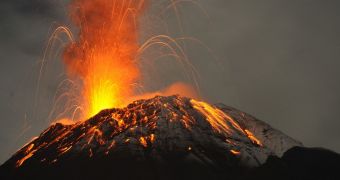They might not publish a collection of prophecies anytime soon, but, thanks to a discovery they have recently made, researchers with the University of Liverpool might just end up being referred to as the Nostradamus of the modern world.
Not to beat about the bush, these scientists claim to have reached a better understanding of how volcanoes behave, and that this insight could help researchers figure out what shape a volcanic eruption will take even before it occurs.
In a paper in the journal Nature Geoscience, the scientists detail that the process that their research project focused on and that evidence shows influences the behavior of volcanic eruptions is called frictional melting.
For those unaware, frictional melting is basically science talk for what happens when magma and rocks snuggle up together and melt as a result of the intense heat that they exposed to while rubbing noses, the University of Liverpool specialists explain.
Depending on the makeup of the magma and the rocks that are romancing each other, the magma can take longer to travel to the surface. This is because, once it encounters rocks and becomes attached to them, it can only move forward once enough pressure to force it upwards builds up.
Consequently, it sometimes happens that powerful volcanic eruptions are accompanied by rhythmic earthquakes of a small intensity that researchers believe are caused by the fact that the magma is not traveling towards the surface smoothly, but in repeated bursts.
“Using friction experiments we have shown that the extent of frictional melting depends on the composition of the rock and magma, which determines how fast or slow the magma travels to the surface during the eruption,” says study leader Dr. Jackie Kendrick.
This finding means that frictional melting influences a given volcano's eruption patterns by forcing the magma to travel at a certain speed towards the surface. Hence, information concerning the frictional melting processes occurring within a volcano can help make observations concerning eruption behavior.
“The closer we get to understanding the way magma behaves, the closer we will get to the ultimate goal: predicting volcanic activity when unrest begins. Whilst we can reasonably predict when a volcanic eruption is about to happen, this new knowledge will help us to predict how the eruption will behave,” Dr. Jackie Kendrick details.
“With a rapidly growing population inhabiting the flanks of active volcanoes, understanding the behaviour of lava domes becomes an increasing challenge for volcanologists,” the researcher explains the significance of these findings.

 14 DAY TRIAL //
14 DAY TRIAL //